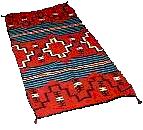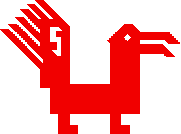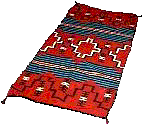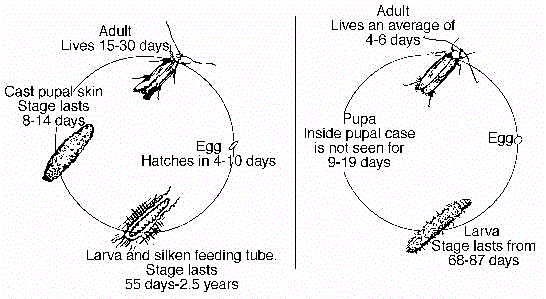

Navajo Rug Appraisal Co.®

 Moths, Carpet Beetles & Destructive Insects
Moths, Carpet Beetles & Destructive Insects
Clothes Moths: The two most common clothes moths, the webbing moth (Tineola Bisselliella) and the casemaking moth (Tinea Pellionella) look very much alike. Both adult moths are buff or tan in color and have a wingspan of about 1/2 inch. They are not strong flyers and are adverse to bright light; instead, they prefer to flit erratically in dark or dimly lit areas. Female moths can lay from 200 to 300 tiny eggs upon a material in which the larvae can feed - primarily wool. The egg-hatching period is about four to eight days but may take longer in cold temperatures. The webbing moth spins a silky coverlet, under which the white-bodied, dark headed larvae feed and then pupate at the conclusion of the feeding period. Its life cycle is variable, extending from three month to a year. The casemaking moth larvae construct a small portable case of the woolen material that it feeds upon. The case enlarges and is dragged about as the larvae feeds. After the feeding stage has concluded, the larvae attaches the case, in which it will pupate, in a secluded place. The length of life cycle is extremely variable, depending on the food supply, temperature and humidity and may last from two months to four years.

Carpet Beetles: Four species of small, oval shaped beetles, may be either solid black or mottled with white, brown, yellow or black. The larvae have gold, brown or black bristles terminating in a tuft of long hairs and grow to be 1/4 to 1/2 inch long, depending on the species.
Although the adult beetles - also known as Buffalo moths - feed on pollen and vegetable matter, their larvae feast on wool, hair and fur. Carpet beetles are more abundant in many areas of the world than clothes moths and are sometimes the cause of damage attributed to moths. The adult beetles are good flyers and can enter houses through open doors and windows. Their destructive larvae may be deposited either as eggs by the adult females or carried into homes on already infested items. As with any destructive insect, a significant infestation may require the use of foggers or fumigation by a professional exterminator. For more detailed information please see carpetbeetles.htm.
Control of rug-damaging insects: If rugs are to be stored for any extended length of time, they should first be cleaned and then mothproofed. Para-dichlorobenzine or naphthalene moth crystals or moth balls are very dangerous to your health and should be avoided (assuming that PDB actually helps prevent moth infestation). These chemicals have been linked to increased fluid pressure within the eyes, anemia and liver damage. Clearly, the odor from PDB never seems to diminish completely. Each rug should be then wrapped in paper rather than plastic as the latter does little to keep out rodents and could possibly cause condensation to form within the package (very slight probability but possible nonetheless). The rugs should the be placed in an area safe from moisture or other harm, away from the walls and off the floor. Cedar lined closets and chests should not be relied upon for complete protection from destructive insects. Also there seems to be only anecdotal evidence supporting such preventatives as newsprint, bay leaves or pepper. The placement of feathers as a bait in order to distract the moths is also unwise as it probably only serves to encourage the problem.
Concern about insect damage should not be limited to stored rugs. Rugs kept in rooms with little traffic or daylight or with portions of carpets that extend under furniture are also subject to moth and beetle infestation. Rugs and weaving that are hanging on walls are particularly susceptible to insect infestation. Even actively used rooms can harbor hordes of destructive insects if they or their food source remain undisturbed. Under ideal conditions, rugs can suffer extensive damage in a surprisingly short time. The ranks of destructive insects include crickets, cockroaches and silverfish.
If damage or evidence of infestation is discovered on your rugs, you can call us to purchase our moth-proofing solution. Freezing the rugs in a chest freezer may be effective if temperaturesare cold enough for a complete kill. Insect foggers are effective in killing infestation of flying moths and larvae if used properly along with thorough vacuuming and additional moth proofing. They are inexpensive and readily available. Caution should be used concerning exposure of vapor to valuable paintings etc. Be advised that the rugs need to be spread flat and should be flipped and fogged again in order to be more certain of effective extermination. Check to see if the infestation extends to other areas of the home, such as wool garments or furniture. It is best to be thorough.
 Navajo Rug Appraisal Co.®
Navajo Rug Appraisal Co.®